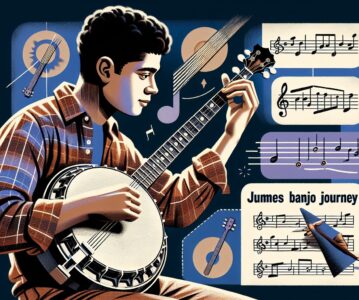If you’ve ever been curious about learning to play the banjo, you’re in luck! The banjo is a fun and versatile instrument that can be picked up by beginners with a little practice and dedication. With its distinctive sound and unique playing style, the banjo has been a popular choice for many musicians and enthusiasts alike.
In this guide, we’ll cover some basic tips and techniques to help you get started on your banjo playing journey. Whether you’re a complete beginner or someone with some musical background, these tips will help you familiarize yourself with the instrument and get you playing in no time.
Understanding the Banjo
The banjo is a stringed instrument that typically has five strings, although there are variations with four or six strings. The most common type of banjo is the 5-string banjo, which consists of four long strings and one shorter string, known as the drone string. The banjo is known for its bright and twangy sound, which is produced by plucking or strumming the strings with either your fingers or a pick.
Getting to Know Your Banjo
Before you start playing, it’s important to familiarize yourself with the different parts of your banjo. The main components of a banjo include the head, the neck, the pot (body), the bridge, and the strings. Take some time to examine your banjo and understand how each part contributes to the overall sound and playability of the instrument.
Tuning Your Banjo
One of the first things you’ll need to do before you start playing is to tune your banjo. The most common tuning for a 5-string banjo is G-D-G-B-D, with the fifth string tuned to a high G note. You can use an electronic tuner or a tuning app to help you get your banjo in tune. Regular tuning is essential for producing clear and harmonious sounds while playing the banjo.
Basic Playing Techniques
Once your banjo is tuned, it’s time to start playing! There are several different playing techniques you can use on the banjo, including fingerpicking, clawhammer, and strumming. Experiment with each technique to see which one feels most comfortable for you. Remember to start slow and practice regularly to improve your skills and build your confidence as a banjo player.
Learning Your First Song
To get a feel for playing the banjo, start by learning a simple song or melody. You can find beginner-friendly banjo tabs and tutorials online, or you can create your own versions of familiar songs. Practice playing the song slowly and focus on hitting the right notes and maintaining a steady rhythm. As you become more comfortable with playing, you can gradually increase the tempo and add your own personal flair to the music.
Joining a Banjo Community
Playing the banjo can be a rewarding and fulfilling experience, but it can also be challenging at times. Joining a banjo community or taking lessons from a qualified instructor can help you stay motivated and inspired as you continue to learn and grow as a musician. Surrounding yourself with fellow banjo enthusiasts can provide you with valuable support and feedback to help you improve your skills and reach your musical goals.
Conclusion
Learning to play the banjo is a fun and rewarding experience that can open up a world of musical possibilities. With a little time and dedication, you can become a proficient banjo player and enjoy making music in a unique and enjoyable way. Remember to be patient with yourself as you learn and practice, and don’t be afraid to seek guidance from experienced banjo players or instructors along the way. So pick up your banjo, start strumming those strings, and embark on an exciting musical journey that’s sure to bring you joy and satisfaction.


